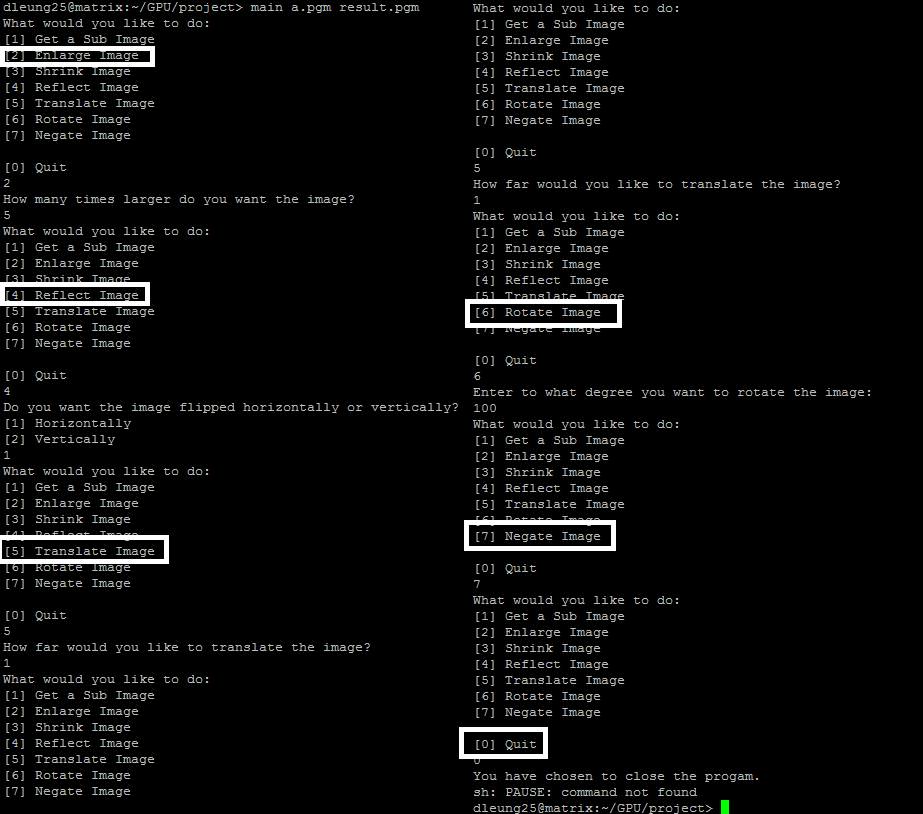Difference between revisions of "Three-Star"
(→Image Profiling) |
(→Image Profiling) |
||
| Line 20: | Line 20: | ||
Rotated and negated the image. | Rotated and negated the image. | ||
| − | [[ | + | [[File:Imageprofilesteps.png]] |
>g++ -g -O2 -pg -omain main.cpp | >g++ -g -O2 -pg -omain main.cpp | ||
>main baboonsizetwo | >main baboonsizetwo | ||
Revision as of 22:06, 7 April 2018
GPU610/DPS915 | Student List | Group and Project Index | Student Resources | Glossary
Contents
Three-Star
Team Members
Progress
Assignment 1
Image Profiling
Chosen to profile image profiling as shown here: http://www.dreamincode.net/forums/topic/76816-image-processing-tutorial/ , using the sample program files (main/image.h/image.cpp)
Slightly modified main.cpp to accomodate larger images.
Had to expand a PGM image (to about 1~MB size) to return any meaningful result (Using a regular sized PGM image of 11KB yielded no meaningful results)
Rotated and negated the image.
 >g++ -g -O2 -pg -omain main.cpp
>main baboonsizetwo
>gprof -p -b main>main.flt
>g++ -g -O2 -pg -omain main.cpp
>main baboonsizetwo
>gprof -p -b main>main.flt
The results of the flat profile:
Flat profile:
Each sample counts as 0.01 seconds.
% cumulative self self total time seconds seconds calls ms/call ms/call name 30.00 0.03 0.03 writeImage(char*, Image&) 30.00 0.06 0.03 Image::rotateImage(int, Image&) 10.00 0.07 0.01 2 5.00 5.00 Image::Image(int, int, int) 10.00 0.08 0.01 2 5.00 5.00 Image::operator=(Image const&) 10.00 0.09 0.01 Image::negateImage(Image&) 10.00 0.10 0.01 Image::Image(Image const&) 0.00 0.10 0.00 2 0.00 0.00 Image::~Image() 0.00 0.10 0.00 1 0.00 0.00 _GLOBAL__sub_I__ZN5ImageC2Ev
Out of all the functions tested, rotateImage takes up the largest amount of time. Below is the code for rotateImage:
void Image::rotateImage(int theta, Image& oldImage) {
int r0, c0;
int r1, c1;
int rows, cols;
rows = oldImage.N;
cols = oldImage.M;
Image tempImage(rows, cols, oldImage.Q);
float rads = (theta * 3.14159265)/180.0;
r0 = rows / 2;
c0 = cols / 2;
for(int r = 0; r < rows; r++)
{
for(int c = 0; c < cols; c++)
{
r1 = (int) (r0 + ((r - r0) * cos(rads)) - ((c - c0) * sin(rads)));
c1 = (int) (c0 + ((r - r0) * sin(rads)) + ((c - c0) * cos(rads)));
if(inBounds(r1,c1))
{
tempImage.pixelVal[r1][c1] = oldImage.pixelVal[r][c];
}
}
}
for(int i = 0; i < rows; i++)
{
for(int j = 0; j < cols; j++)
{
if(tempImage.pixelVal[i][j] == 0)
tempImage.pixelVal[i][j] = tempImage.pixelVal[i][j+1];
}
}
oldImage = tempImage;}
Main section to be parallelized.
LZW Data Compression Algorithm
Timothy Moy profiled.
Original algorithm: https://codereview.stackexchange.com/questions/86543/simple-lzw-compression-algorithm
Summary of Profiles
| Size (MB) | Compress() time in seconds |
|---|---|
| 10 | 0.96 |
| 15 | 1.35 |
| 20 | 1.8 |
| 25 | 2.14 |
| 30 | 2.64 |
| 35 | 3.16 |
| 40 | 3.45 |
| 45 | 4.24 |
| 50 | 4.23 |
The compress function seems to have some room for improvement as can be seen in the source code below
void compress(string input, int size, string filename) {
unordered_map<string, int> compress_dictionary(MAX_DEF);
//Dictionary initializing with ASCII
for ( int unsigned i = 0 ; i < 256 ; i++ ){
compress_dictionary[string(1,i)] = i;
}
string current_string;
unsigned int code;
unsigned int next_code = 256;
//Output file for compressed data
ofstream outputFile;
outputFile.open(filename + ".lzw");
// Possible area for improvement via reduction
for(char& c: input){
current_string = current_string + c;
if ( compress_dictionary.find(current_string) ==compress_dictionary.end() ){
if (next_code <= MAX_DEF)
compress_dictionary.insert(make_pair(current_string, next_code++));
current_string.erase(current_string.size()-1);
outputFile << convert_int_to_bin(compress_dictionary[current_string]);
current_string = c;
}
}
if (current_string.size())
outputFile << convert_int_to_bin(compress_dictionary[current_string]);
outputFile.close();
}
Note the comment above the second for loop notes we can do something like this:
for (int i = 1; i < n; i+=) a[0] += a[i];
changed to
for (int s = 1; s <= n/2; s*=2) for(int j = 0; j < n; j +=2 * s) a[j] += a[j + s];
The first for loop is constant and probably won't show much improvement if we parallelize it. As such, the major hotspot in this function is the second for loop. This is especially true since the file might be very large and we may be dealing with millions of characters!
Conclusion
We decided to go with image profiling.
There are some possible issues with working with the simple-lzw-compression-algorithm and CUDA. You cannot use the C++ string type in a kernel because CUDA does not include a device version of the C++ String library that would be able run on the GPU. Even if it was possible to use string in a kernel, it's not something you would want to do because string handles memory dynamically, which would be likely to be slow.
Char explanation (replace tmr) - https://stackoverflow.com/questions/26993351/is-there-a-penalty-to-using-char-variables-in-cuda-kernels?utm_medium=organic&utm_source=google_rich_qa&utm_campaign=google_rich_qa